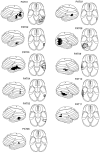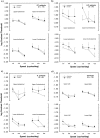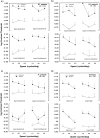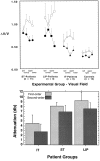Detection and discrimination of first- and second-order motion in patients with unilateral brain damage
- PMID: 8987802
- PMCID: PMC6573252
- DOI: 10.1523/JNEUROSCI.17-02-00804.1997
Detection and discrimination of first- and second-order motion in patients with unilateral brain damage
Abstract
The present investigation explored the extent to which extrastriate cortex is necessary for various aspects of motion processing and whether the processing of first-order (Fourier) and second-order (non-Fourier) motion involves the same extrastriate cortical regions. Orientation, direction, and speed discrimination thresholds were measured in 21 patients with unilateral damage to the lateral occipital, temporal, or posterior parietal cortex. Their results were compared with those of 14 age-matched control subjects. The stimuli were static random-dot noise patterns, the luminance of which (first-order) or contrast (second-order) was modulated by a drifting sinusoid. Each image was presented at an eccentricity of 5.6 deg in one of the four visual quadrants. The contrasts required to identify orientation and direction were measured in a forced-choice paradigm for three speeds (1.5, 3, and 6 deg/sec). Speed discrimination performance was measured for stimuli presented simultaneously in two of the four quadrants. The results indicate the following: (1) orientation thresholds were increased only slightly in the patients; (2) direction thresholds were modestly elevated, and this effect was more pronounced for second-order stimuli than for first-order stimuli; (3) speed discrimination thresholds were elevated significantly in the patients with lesions in the region bordering superior-temporal and lateral-occipital cortex; and (4) speed discrimination thresholds for first-order stimuli were more elevated than those for second-order stimuli. The results suggest that there is substantial overlap in the cortical areas involved in first- and second-order speed discrimination.
Figures









Similar articles
-
Visual short-term memory of stimulus velocity in patients with unilateral posterior brain damage.J Neurosci. 1995 Mar;15(3 Pt 2):2287-300. doi: 10.1523/JNEUROSCI.15-03-02287.1995. J Neurosci. 1995. PMID: 7891167 Free PMC article.
-
Impaired visual motion perception in the contralateral hemifield following unilateral posterior cerebral lesions in humans.Brain. 1993 Dec;116 ( Pt 6):1303-35. doi: 10.1093/brain/116.6.1303. Brain. 1993. PMID: 8293273
-
Deficits and recovery of first- and second-order motion perception in patients with unilateral cortical lesions.Eur J Neurosci. 1998 Jun;10(6):2117-28. doi: 10.1046/j.1460-9568.1998.00224.x. Eur J Neurosci. 1998. PMID: 9753098
-
First-order and second-order motion: neurological evidence for neuroanatomically distinct systems.Prog Brain Res. 2004;144:197-212. doi: 10.1016/S0079-6123(03)14414-7. Prog Brain Res. 2004. PMID: 14650850 Review.
-
Behavioral cartography of visual functions in cat parietal cortex: areal and laminar dissociations.Prog Brain Res. 2001;134:265-84. doi: 10.1016/s0079-6123(01)34018-9. Prog Brain Res. 2001. PMID: 11702548 Review.
Cited by
-
Illusions of visual motion elicited by electrical stimulation of human MT complex.PLoS One. 2011;6(7):e21798. doi: 10.1371/journal.pone.0021798. Epub 2011 Jul 13. PLoS One. 2011. PMID: 21765915 Free PMC article.
-
The contribution of LM to the neuroscience of movement vision.Front Integr Neurosci. 2015 Feb 17;9:6. doi: 10.3389/fnint.2015.00006. eCollection 2015. Front Integr Neurosci. 2015. PMID: 25741251 Free PMC article. Review.
-
Sensitivity to first- and second-order drifting gratings in 3-month-old infants.Iperception. 2011;2(5):440-57. doi: 10.1068/i0406. Epub 2011 Aug 8. Iperception. 2011. PMID: 23145237 Free PMC article.
-
The processing of first- and second-order motion in human visual cortex assessed by functional magnetic resonance imaging (fMRI).J Neurosci. 1998 May 15;18(10):3816-30. doi: 10.1523/JNEUROSCI.18-10-03816.1998. J Neurosci. 1998. PMID: 9570811 Free PMC article.
-
A new approach to analysing texture-defined motion.Proc Biol Sci. 2001 Dec 7;268(1484):2435-43. doi: 10.1098/rspb.2001.1829. Proc Biol Sci. 2001. PMID: 11747561 Free PMC article.
References
-
- Adelson EH, Bergen JR. Spatiotemporal energy models for the perception of motion. J Opt Soc Am A. 1985;2:284–299. - PubMed
-
- Albright TD. Direction and orientation selectivity of neurons in visual area MT of the macaque. J Neurophysiol. 1984;52:1106–1130. - PubMed
-
- Chubb C, Sperling G. Drift-balanced random stimuli: a general basis for studying non-Fourier motion perception. J Opt Soc Am A. 1988;5:1986–2006. - PubMed
-
- Derrington AM, Badcock DR. Separate detectors for simple and complex patterns? Vision Res. 1985;25:1869–1878. - PubMed
Publication types
MeSH terms
LinkOut - more resources
Full Text Sources
Other Literature Sources
